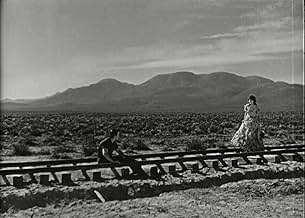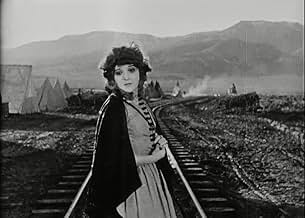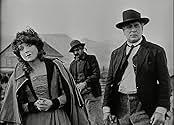ÉVALUATION IMDb
7,2/10
2,7 k
MA NOTE
Ajouter une intrigue dans votre langueAfter witnessing the murder of his father by a renegade as a boy, the grown-up Brandon helps to realize his father's dream of a transcontinental railway.After witnessing the murder of his father by a renegade as a boy, the grown-up Brandon helps to realize his father's dream of a transcontinental railway.After witnessing the murder of his father by a renegade as a boy, the grown-up Brandon helps to realize his father's dream of a transcontinental railway.
- Prix
- 2 victoires au total
J. Farrell MacDonald
- Cpl. Casey
- (as J. Farrell Macdonald)
Jim Welch
- Pvt. Schultz
- (as James Welch)
- …
George Waggner
- Buffalo Bill Cody
- (as George Wagner)
James A. Marcus
- Judge Haller
- (as James Marcus)
Chief John Big Tree
- Cheyenne Chief
- (uncredited)
Chris Willow Bird
- Indian
- (uncredited)
Danny Borzage
- Worker
- (uncredited)
George Brent
- Worker
- (uncredited)
Milton Brown
- Minor Role
- (uncredited)
Thomas Carr
- Rail Worker
- (uncredited)
Avis en vedette
In Springfield, the surveyor Brandon dreams on building the first transcontinental railroad while his skeptical friend Thomas Marsh (Will Walling), who is a small constructor, believes he is nothing but a dreamer chasing a rainbow; their children Davy Brandon and Miriam Marsh are best friends. Brandon heads with Davy to the west, where he finds a possible pass for the railroad. However, a group of Cheyenne led by a white renegade kills and scalps Brandon; Davy, who is hidden, sees that the killer has only two fingers in his right hand. In June 1862, President Abraham Lincoln (Charles Edward Bull) authorizes the construction of two railroads: the Union Pacific from Omaha, Nebraska, to West; and the Central Pacific, from Sacramento, California, to East. His old friend Thomas Marsh is responsible for the construction of the Union Pacific and his daughter Miriam (Madge Bellamy) is engaged of his engineer Jesson (Cyril Chadwick). After many incidents during the construction, Thomas Marsh is short of money and he needs to find a shortcut other than the original route through Smoky River. However, the powerful Bauman (Fred Kohler) that owns the lands where the railroad should pass, bribes Jesson to keep the original route. When the grown-up Davy (George O'Brien) appears in the town bringing the mail, Miriam is glad in meeting him and he tells to Thomas that his father had discovered a pass through the Black Hills. Thomas assigns Jesson to ride with Davy to check the ravine, but Bauman convinces the engineer to kill the rival. Jesson cuts the rope that Davy is using to descent to the pass; returns to town and tells that Davy had an accident and died. However, when Davy returns to town, he discloses the truth and the situation of the engineer becomes unbearable. The desperate Bauman uses the two fingered renegade to convince the Cheyenne to war against the workers and Davy has the chance to meet the killer of his father. On 10 May 1869, the locomotives 116 and Jupiter meets each other in the intersection of the Union Pacific and the Central Pacific.
"The Iron Horse" is indeed an impressive silent epic western of John Ford. Of course this western is flawed, with excessive patriotism, subplots and running time of 150 minutes. But considering the limited and primitive technical resources in 1924, it is amazing how the director could have made, for example, the scene of the stampede or the Cheyenne attack. Further, there are unusual angles of camera and the take from below the train arriving to save the workers is sensational in the prime cinema that used huge cameras. The plot seems to be based on the true story of the two North-American transcontinental railroads and the lead story of Davy, Miriam and her father is engaging. My vote is eight.
Title (Brazil): "Cavalo de Ferro" ("Iron Horse")
"The Iron Horse" is indeed an impressive silent epic western of John Ford. Of course this western is flawed, with excessive patriotism, subplots and running time of 150 minutes. But considering the limited and primitive technical resources in 1924, it is amazing how the director could have made, for example, the scene of the stampede or the Cheyenne attack. Further, there are unusual angles of camera and the take from below the train arriving to save the workers is sensational in the prime cinema that used huge cameras. The plot seems to be based on the true story of the two North-American transcontinental railroads and the lead story of Davy, Miriam and her father is engaging. My vote is eight.
Title (Brazil): "Cavalo de Ferro" ("Iron Horse")
A young boy grows to fulfill his murdered father's vision of seeing THE IRON HORSE, the mighty transcontinental railway, stitch the country together, binding East to West.
Bursting with excitement & patriotic fervor, THE IRON HORSE is the film which put young director John Ford on the cinematic map. He brought together all he had learned from years of making shorter, smaller films and he produced a product which heralded his enormous contributions to sound films in the years to come. This is a `director's picture' in that the stars, as good as they are, are almost negligible; what was important here was Ford's vision & his ability to place it before the audience. Indeed, he does not even bring his leading man (George O'Brien) on screen until 45 minutes into the story - a shortcut to disaster almost anywhere else.
(In all fairness it should be noted that O'Brien, handsome & strong-limbed, does very well as the gentle hero. He would find similar roles in other epic films of the decade. J. Farrell MacDonald, as Irish Corporal Casey, is the prototype for many comically eccentric fellows who would appear in other Ford westerns.)
The film often takes on the aspects of an ancient newsreel. Cattle drives, Indian attacks & endless track laying all look utterly real. Particularly fascinating is the depiction of the dismantlement of the end-of-the-track town, so that not even a dog is left, as it is moved many miles further on to the west. This type of arcane information is what makes watching very old films so enjoyable.
THE IRON HORSE represented the largest migration out of Hollywood for location shooting up to that time. Nothing like this had been attempted before, so Ford & his lieutenants were forced to make up the rules as they went along.
Hiring a circus train, the small army of extras arrived at the subzero Nevada location in January of 1924. The conditions which greeted them were authentically primitive. It was so cold, the extras quickly began sleeping in their costumes. Finding the train to be flea ridden, they moved into the sets and began living exactly as the characters they were portraying. The female extras especially suffered from the rugged conditions. A frontier mindset seemed to take over many of the cast & crew; the circus tent, which doubled as both the movie saloon and the crew's commissary, eventually had to have the catsup bottles removed from the tables to discourage the many fights which kept breaking out.
Authenticity found its way into the movie in other, more positive, ways. Several of the elderly Chinese extras, representing laborers on the Central Pacific, had actually worked on the real McCoy sixty years previous. They came out of retirement to appear in the film & enjoyed themselves immensely. Ford also managed to locate the two original locomotives which met at Promontory Point, Utah, in 1869 and reunited them for the film's climax.
Composer John Lanchbery has contributed a splendid soundtrack to the restored video version, incorporating several contemporaneous tunes of the period. It would be intriguing to double bill THE IRON HORSE with Cecil B. DeMille's UNION PACIFIC (1939), which tells the same historical story, but with a completely different tack & set of fictional characters.
Bursting with excitement & patriotic fervor, THE IRON HORSE is the film which put young director John Ford on the cinematic map. He brought together all he had learned from years of making shorter, smaller films and he produced a product which heralded his enormous contributions to sound films in the years to come. This is a `director's picture' in that the stars, as good as they are, are almost negligible; what was important here was Ford's vision & his ability to place it before the audience. Indeed, he does not even bring his leading man (George O'Brien) on screen until 45 minutes into the story - a shortcut to disaster almost anywhere else.
(In all fairness it should be noted that O'Brien, handsome & strong-limbed, does very well as the gentle hero. He would find similar roles in other epic films of the decade. J. Farrell MacDonald, as Irish Corporal Casey, is the prototype for many comically eccentric fellows who would appear in other Ford westerns.)
The film often takes on the aspects of an ancient newsreel. Cattle drives, Indian attacks & endless track laying all look utterly real. Particularly fascinating is the depiction of the dismantlement of the end-of-the-track town, so that not even a dog is left, as it is moved many miles further on to the west. This type of arcane information is what makes watching very old films so enjoyable.
THE IRON HORSE represented the largest migration out of Hollywood for location shooting up to that time. Nothing like this had been attempted before, so Ford & his lieutenants were forced to make up the rules as they went along.
Hiring a circus train, the small army of extras arrived at the subzero Nevada location in January of 1924. The conditions which greeted them were authentically primitive. It was so cold, the extras quickly began sleeping in their costumes. Finding the train to be flea ridden, they moved into the sets and began living exactly as the characters they were portraying. The female extras especially suffered from the rugged conditions. A frontier mindset seemed to take over many of the cast & crew; the circus tent, which doubled as both the movie saloon and the crew's commissary, eventually had to have the catsup bottles removed from the tables to discourage the many fights which kept breaking out.
Authenticity found its way into the movie in other, more positive, ways. Several of the elderly Chinese extras, representing laborers on the Central Pacific, had actually worked on the real McCoy sixty years previous. They came out of retirement to appear in the film & enjoyed themselves immensely. Ford also managed to locate the two original locomotives which met at Promontory Point, Utah, in 1869 and reunited them for the film's climax.
Composer John Lanchbery has contributed a splendid soundtrack to the restored video version, incorporating several contemporaneous tunes of the period. It would be intriguing to double bill THE IRON HORSE with Cecil B. DeMille's UNION PACIFIC (1939), which tells the same historical story, but with a completely different tack & set of fictional characters.
This film was on my radar for a long time.
Saw this few days back on a dvd. Fortunately it was a US version of 2 hours 29 mins but was a lil upset when I heard about the bluray release date set for November. I enjoy watching western films on blurays.
This film is an epic about the creation of the first transcontinental railroad. The film portrayed the backbreaking hardwork, the toils of the men and the determination.
George O'Brien plays the young man whose father was murdered for finding a shorter route through a gorge. O'Brien is adamant to fulfil his father's dream inspite of obstruction n a murder attempt.
I was shocked to know that many poor farmers' land was usurped for the project n this was one of the reason for turning the James brothers into outlaws.
Since I live in Cheyenne, WY this type of movie really appeals to me. As all historians know, various towns along the route of this railroad (which coincides quite closely to interstate 80 in Wyoming) were made during its construction. Cheyenne and Rock Springs (because of its coal mining) were especially notable.
I had seen this movie several years ago and was delighted to see it being broadcast on the Turner Classic Movies channel. Perhaps they will re-broadcast it again in the future.
This movie, while not completely accurate historically, certainly gives an idea of the magnitude of the endeavor being undertaken. And it does feature a real locomotive which operated on the railroad during the period portrayed. Historical buffs definitely should not be swayed from enjoying this title simply because it may not strictly conform to history.
I won't go into the story except to say that the various sub-plots keep the viewer very entertained. This was a very well-done movie in my opinion. Acting was very good. And the cinematography was very impressive.
Fans of either westerns or silent-era films certainly should not miss this one.
I had seen this movie several years ago and was delighted to see it being broadcast on the Turner Classic Movies channel. Perhaps they will re-broadcast it again in the future.
This movie, while not completely accurate historically, certainly gives an idea of the magnitude of the endeavor being undertaken. And it does feature a real locomotive which operated on the railroad during the period portrayed. Historical buffs definitely should not be swayed from enjoying this title simply because it may not strictly conform to history.
I won't go into the story except to say that the various sub-plots keep the viewer very entertained. This was a very well-done movie in my opinion. Acting was very good. And the cinematography was very impressive.
Fans of either westerns or silent-era films certainly should not miss this one.
1st watched 10/25/2013 -- 7 out of 10(Dir-John Ford): Epic silent movie about the path to the completion of the transcontinental railroad seen thru the eyes of the son of a dream-filled mid-westerner, played by George O'Brien in adulthood. This movie does a pretty good job of portraying the conflicts in the effort -- while throwing in some romance with a few fist fights. John Ford, the King of the Western, directed this early movie and is not afraid to show men having emotion and being aggressive as males are expected to be. George's character, Dave Brandon, travels with his father to the west in search of helping the railroad get built, but his father is killed by a white man dressed as an Indian and traveling with their tribe. This man becomes the evil character in the film an we find out he also is tight with the railroad executives and owns a lot of land. We believe his intention is to make sure the railroad goes thru his areas so they will thrive and make him money although it is not really dramatized. This piece is somewhat historical in nature with some comedy, romance and violence thrown in coming a lot from the romantic triangle between Brandon, his childhood girlfriend and her new fiancé. The fight scenes are a little corny and sometimes un-necessary but some of the emotions come out due to this and help the film, in my opinion. Ford makes the film entertaining and not just a bland documentary which it could have been. His ability to entertain an audience shines and the film also teaches which is a positive thing as well. Overall -- a worthwhile film although not perfect.
Le saviez-vous
- AnecdotesThe kitchen staff for the film was made up largely of Chinese cooks. Some of them had been workers on the transcontinental railroad in 1869, the same construction project that forms the basis of this film.
- GaffesThe locomotives and rolling stock use knuckle-type couplers, which did not begin wide use until the 1890s. In the 1860s-era setting of this movie, the couplers in use would have been link-and-pin. This anachronism is understandable as the safety issue would have prohibited the use of the era-appropriate link-and-pin couplers.
- Citations
Thomas Marsh: [after Brandon, Sr. leaves to go west to pursue building a transcontinental railroad] Poor dreamer - he's chasing a rainbow!
Lincoln: Yes, Tom - and some day men like you will be laying rails along that rainbow.
- Autres versionsThe DVD release of this film contains two different edits, one for the American market and one for Europe. The American release is 16 minutes longer than the European cut. The American cut is dedicated to the memory of Abraham Lincoln while the European release is dedicated to the memory of George Stephenson. In the American release Fred Kohler's character is named Deroux while in the European cut his character is named Bauman.
- ConnexionsEdited into The Story of Our Flag (1939)
- Bandes originalesBlow the Man Down
(uncredited)
Traditional 19th Century Sea Chanty (1860s)
[Integrated into restoration score into divorce and going back to work scenes]
Meilleurs choix
Connectez-vous pour évaluer et surveiller les recommandations personnalisées
- How long is The Iron Horse?Propulsé par Alexa
Détails
Box-office
- Budget
- 450 000 $ US (estimation)
- Durée
- 2h 30m(150 min)
- Mixage
- Rapport de forme
- 1.33 : 1
Contribuer à cette page
Suggérer une modification ou ajouter du contenu manquant


































